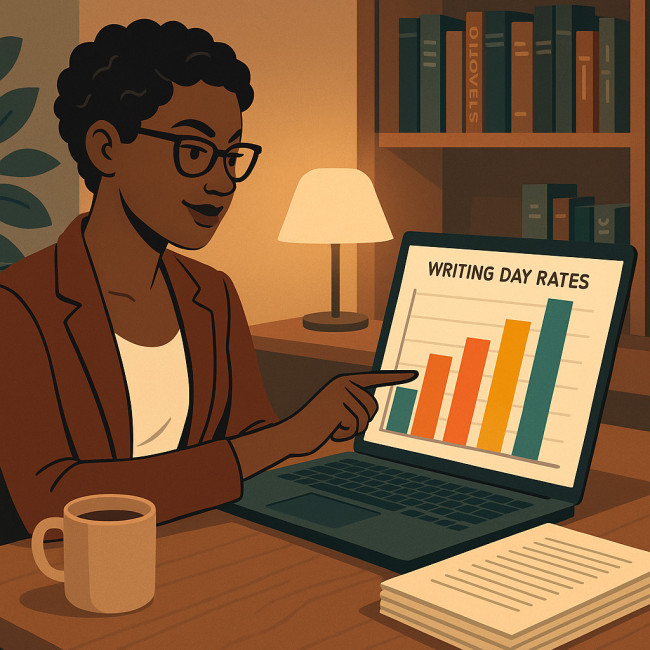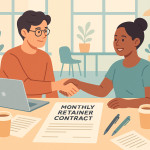Author day rates demystified: industry benchmarks and winning negotiation moves
Wondering what to charge per day as a professional author? This guide breaks down current industry benchmarks, explains the variables behind every figure and equips you with negotiation tactics that safeguard your creativity—and your income.
Why understanding author day rates is mission-critical

Whether you write novels, white papers or brand stories, a transparent day rate anchors your value in any project discussion. It lets clients compare apples to apples, protects you from scope creep and positions you as a seasoned pro rather than “just another freelancer” in an author directory. It also simplifies budgeting for your clients, enables you to forecast your own revenue with greater accuracy, and serves as a psychological signal that you treat your craft like a real business rather than a casual side hustle. A rock-solid rate essentially becomes your creative moat, reinforcing boundaries and freeing up mental bandwidth for the deep work of storytelling.
Industry benchmarks for author day rates in 2024
Rates vary by niche and experience, but the table below captures median numbers reported by professional bodies such as the Society of Authors (UK) and the Editorial Freelancers Association (US).
| Experience level | Fiction (€) | Non-fiction (€) | Copywriting (€) | Technical writing (€) | Ghostwriting (€) |
|---|---|---|---|---|---|
| 0–3 years | 180–230 | 220–270 | 250–300 | 320–380 | 350–420 |
| 3–7 years | 230–300 | 270–330 | 300–370 | 380–450 | 420–520 |
| 7 years + | 300–400 | 330–450 | 370–500 | 450–600 | 520–700 |
Source : Editorial Freelancers Association
Key takeaways
- Sector premium: Technical writing and ghostwriting command the highest daily fees due to specialised knowledge and higher liability exposure.
- Experience multiplier: Each three-year milestone typically adds 15–20 % to your baseline rate.
- Regional variance: Clients in major hubs (London, Berlin, Paris) can absorb 10–15 % higher fees than smaller markets.
Five factors that shape your personal rate
- Scope complexity. A 10-page e-book with heavy research beats an 800-word blog post any day.
- Rights transfer. Full buyout justifies a surcharge of up to 30 % compared with limited-use licences.
- Turnaround speed. Tight deadlines can warrant a rush fee (usually +25 %).
- Client type. Agencies may pay less than direct brands but offer repeat work; adjust accordingly.
- Ancillary tasks. Interviews, image sourcing and revisions should appear as separate line items.
Winning negotiation moves
Negotiation starts long before the first email. Use these tactics to anchor a higher figure without burning bridges:
- Cite external benchmarks. Mention industry data to give your rate objective weight.
- Bundle deliverables. Offer a day rate discount if the client books a multi-day package—an elegant upsell to secure a retainer.
- Reference-check neutrality. Ask politely whether they have a well-prepared brief; gaps here often justify a consulting fee.
- Set revision caps. Two rounds included; extra feedback triggers a new day rate.
- Use silence strategically. After quoting, pause. Many clients meet your ask rather than renegotiate.
Email line that seals deals
“Based on current EFA benchmarks and the specialised nature of your SaaS white paper, my day rate is €420. For a three-day block booked this month, I can extend a 10 % partnership discount.”
Crafting a rate card that sells
Design a one-page PDF or webpage featuring three clear tiers:
- Essentials – €X/day: Writing only, limited licence.
- Growth – €Y/day: Writing + two interviews + SEO optimisation.
- Authority – €Z/day: Everything in Growth plus social-media snippets and quarterly strategy call.
Pair this with LinkedIn pitching scripts to land discovery calls faster.
Case study: From €300 to €450 in four emails
Marina, a mid-career non-fiction author, secured a rate increase by:
- Sharing a concise portfolio link.
- Quoting the EFA range and outlining her unique research skills.
- Offering a modest discount for prompt payment.
- Requesting a written contract addendum to lock scope.
Result: a 50 % day-rate boost plus a three-month retainer.
Quiz: Are you leaving money on the table?
FAQ
- Should I ever publish my day rate publicly?
- Posting a “from” rate on your website filters out low-budget inquiries while leaving room to customise final quotes.
- How do I handle clients who pay by the word?
- Convert their per-word budget into an equivalent day fee and negotiate from there; explain the efficiency gains of bundled time.
- Is charging by day legal worldwide?
- Yes, but clarify whether your day equals seven or eight hours, and comply with local tax laws.
- What if a client wants unlimited revisions?
- Include a cap in the contract and quote an hourly or daily rate for additional rounds.
- Can I mix day rates with royalties?
- Absolutely. Many ghostwriters accept a lower day fee in exchange for a small royalty override on book sales.
Take action today
Audit your current projects, update your rate card and test one negotiation tactic this week. Future you—and your bank balance—will thank you.
Ready to position yourself as a premium writer? Start by fine-tuning your author profile and pitching your refreshed day rate to three prospects before Friday.











